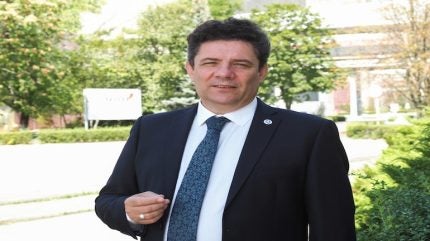
Russia’s government and the nuclear industry have set a task to restart units of the Zaporizhia NPP (ZNPP) as soon as the situation allows, Rosatom has said. Plant Director Yuriy Chernichuk explained what needs to be done to relaunch the plant after a long downtime in an interview with Strana Rosatom.
Russia took control of ZNPP in March 2022 and the following September a referendum was held in Zaporozhye region in which according to Russian officials of the Central Election Commission 93.11% (of 541,093 voters) favoured joining the Russian Federation on a turnout of 85.4%. On 5 October, Russian President Vladimir Putin signed a decree formally transferring ZNPP to Russian jurisdiction under nuclear utility Rosenergoatom (part of Rosatom). A Russian Federal State Unitary Enterprise, JSC Zaporizhia NPP, has been established by Rosenergoatom to operate the plant.
While Ukrainian nuclear utility Energoatom continues to claim ownership of the plant, Russia’s Foreign Ministry said on 25 March: “The return of the plant to the Russian nuclear industry is a fait accompli that the international community needs to recognise. The transfer of the ZNPP or control over it to Ukraine or other states is excluded.” The same day, Russia’s Permanent Representative in Vienna, Mikhail Ulyanov, confirmed that the Russian Federation will not allow joint control over the plant with Kiev, the USA, or international organisations.
Chernichuk said: “We consider as the most realistic option to first restart units 2 and 6 [of ZNPP] which have Russian-made fuel loaded. He noted that all six units were shut down in September 2022. Since then several units were maintained in hot shutdown mode to provide heat for the plant and for the operators’ town of Energodar. “But this mode is very different from power production mode, so the amount of work that we have to do before launching is quite large.”
He said the most ambitious task will be the provision of water. “As you know, in June 2023, the armed forces of Ukraine destroyed the dam of the Kakhovka reservoir, the dam of the Kakhovskaya hydroelectric power station, which led to the loss of the regular scheme for replenishing our cooling pond and, accordingly, the needs of the station.”
He said the first task is to recharge of the cooling pond and restore the chemical regime. “Nuclear power plants have special requirements for water. For two years now, our pond has been closed with a broken water circulation system. There is no water exchange, and the water composition is not what is required for the operation of nuclear power plants. Therefore, it is necessary to find a source to replenish the pond.
Asked about possible options, he replied: “We are working on various projects. We are considering the Dnieper River as a source of water. All the technical solutions are clear to us. But of course, it will take some time to implement them. This is not a matter of one day or one month. And I must immediately make a reservation that the starting point for the implementation of all the measures that we are discussing will be the end of hostilities and some kind of guarantee of peace at the Zaporizhia NPP and in the adjacent territory.
Once the water issue is resolved the next task will be to decide on where power from the plant would be delivered. “To date, three of the four power lines that were used to supply power before the start of the special military operation have been disabled and destroyed. There is only one in operation, which goes to the opposite bank [ of the Dnieper], that is, to the Ukrainian side. Restoring these lines will be a federal task. And we need to have a consumer. Energodar consumes only 15 MWe at its peak in winter and just one of our units produces 1,000 MWe.”
During the Soviet Union, when ZNPP was constructed, it had three major electricity consumers – large steelmaking and metallurgical plants in Krivoy Rog and Nikopol, now in Ukraine; the city of Zaprozhye, under Ukrainian control but claimed by Russia; “and Mariupol with its factories, which in 2022 were completely destroyed during the liberation of the city”. In 2019, the Kakhovskaya line was built, which went to Kakhovka with plans to connect it to Odessa and Nikolaev and also to Crimea.
Chernichuk speculated that in future the plant could supply power to Mariupol and further east, to Donetsk. This would make it possible to redirect power of the nearby Rostov NPP to the energy-deficient North Caucasus. “Because 6,000 MWe is quite a serious capacity even for such a large country as ours, it will require a redistribution of electricity flows.”
As to other tasks before restarting the plant it will be necessary to carry out extensive work on equipment inspection, repairs, and confirming the operability and readiness of the units for operation.
“After the referendum in 2022 and the presidential decree on the status of ZNPP, we were given until 2028 to bring our activities in line with [Russian] federal laws, rules and regulations, including licensing. So, by the end of 2027, we must obtain licences for all units. Our regulator recognised the licence of Ukrainian nuclear supervision as transitional. But for units 2 and 6, it ends in February and October 2026, respectively.”
He added: “There is one more point. Many sanctions have been imposed against Russia, a policy of maximum import substitution has been adopted at the state level. Everything that we bought abroad, we now have to produce ourselves. From 1991, when the Soviet Union collapsed until 2022… a lot of equipment was purchased abroad This applied especially to electrical equipment which was significantly different from Russian equipment. This equipment will have to be changed or confirmed as functional.
On the question of fuel, it is maintained and checked. “Today I know that the fuel is intact, everything is fine with it,” Chernichuk said. “Of course, we can only predict how it will behave when we start putting the unit into operation. But I don’t think there will be any problems. Even in the worst-case scenario and it is unusable for some reason, I think we will be able to find enough reserves for the core of one unit.”
Staffing will be another issue. “Maybe not 100 %, but 90% of all the needs of the station were covered by our staff. We had very few outsourcing companies. But even if we were to return to the number that we had at the end of 2021, we would not have enough staff to carry out the full range of activities. So, of course, we will attract personnel from outside. The Rosenergoatom Concern provides repair and maintenance functions with the help of third-party companies, such as Atomenergoremont and Rosatom Service. Those guys will need to take part in the work at the Zaporizhia NPP.”
He added: “In order to provide the plant with the personnel necessary to maintain it in a safe state, we have attracted the group’s personnel reserve. Specialists from other nuclear power plants come to us on a rotating basis. Of course, they are trained and tested by us and are allowed to work only after they receive permission from Rostechnadzor.”
Despite the difficulties, “We didn’t have a day when there wasn’t enough staff to keep the station in a safe state [and] we have been continuously working on personnel issues. We have a large and serious training program for young professionals. We chose Sevastopol State University, one of the concern’s specialised universities, as our base university. So I don’t expect any critical problems with the personnel that will hinder the possibility of starting the station.”
Asked how the launch process will be organised, Chernichuk said the launch will not differ much from regular procedures. “The scope or types of individual tests can be changed at the request of the regulator or if we deem it necessary.”
Of course, it will be a landmark moment for everyone when the first unit is restarted. “I was at the station on 11September 2022, in the dead of night, when the last unit was disconnected from the network. Immediately there was a deathly silence. At NPPs something is always humming, the equipment is working, and here everything stopped working! The windows were open, warm, and you could hear September. The overhead light was buzzing, and Loaf, the local dog, was running around outside, barking. The nuclear scientists, stern adults, had tears in their eyes. So it will be a great achievement and great happiness for me to live to see the units start working again and to take part in it.”
In a recent interview with Reuters, International Atomic Energy Aency Director General Rafael Mariano Grossi said: “In terms of the safety of the plant and the general situation at the plant, I have to say that it is professionally controlled and managed. Some maintenance work … (was) perhaps not as comprehensive as we could have had, but this is also a function of the war.”
He added: “Despite that, a relatively rapid but gradual restart of the plant, one reactor at a time, should be possible. We’re talking about months, and perhaps for the whole Zaporizhia nuclear power plant to be back and operating in full with all six units, it would take more than a year maybe, perhaps even more.” Operating all the reactors would be “difficult but not impossible”.
He acknowledged the problem of cooling water since the plant’s biggest source, the nearby Kakhovka reservoir, was emptied after its dam was blown up in 2023. That led to wells being dug at Zaporizhia. More ambitious solutions to bring water from further away were ruled out because of the hostilities, but a ceasefire could make them possible






